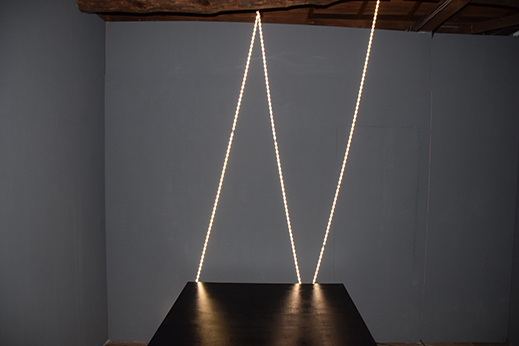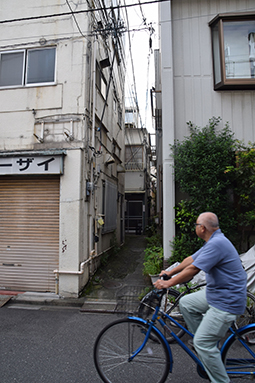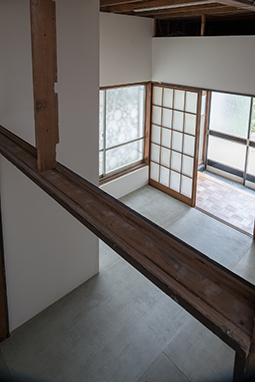 |
Focus features two in-depth reviews each month of fine art, architecture and design exhibitions and events at art museums, galleries and alternative spaces around Japan. The contributors are non-Japanese art critics living in Japan. |
|
|
 |
 |
 |
Asakusa Gallery: High Art in the Low City
Michael Pronko |
 |
The entryway to the exhibition confronts the viewer with opacity as well as transparency. The irony of that duality is important to the compact, focused show. The first floor provides an "easy" entry into the provocative art on the upper floor. |
|
The renovation of the house removed many walls to expose the craftsmanship of the woodwork and foster a more intimate feeling. It's like being in a home, but one given over entirely to the non-practicalities of art. |
The Asakusa Gallery is housed, literally, in a former family residence built in 1965 and renovated in 2015. The energy the gallery commands derives from its combination of unique surroundings, an unexpected use of space, and a powerful concept of art. The gallery is "just" a small remodeled house down an alley a few minutes' walk from the Tawaramachi subway stop in a funky, "low-city" (shitamachi) Tokyo neighborhood adjoining Asakusa. With only two rooms to make its conceptual point, it manages to create an innovative space to rethink what art can be, what it is supposed to do, and how it can be experienced.
The entrance to the gallery is a standard residential genkan that leads into a compact office area and welcoming room. One can imagine visitors and delivery people stopping there to chat for a few minutes, and all gallery-goers must, of course, remove their shoes. After that they can take in the first floor space, which does not take long, and then climb a narrow stairway to the upstairs exhibition room.
The walk from the local shopping street down the cozy lane past small temples to the back-alley house and then up the stairs is a miniature journey to a tranquil, friendly space where art, and art-goers, can feel at home. Visitors can relax here and reconsider art far from the environment and expectations of commercial galleries and large museums.
 |
|
The minimalism of the back wall establishes tension with the colors, sound, motion, and blending of images projected on the front wall. The back area is calm and sedate, while the front video is wild and confrontational. |
The current exhibition, The Right to Opacity, which runs until 13 October, presents the work of Pauline Boudry and Renate Lorenz, video artists from Berlin. It is based on writings by Jean Genet and delivered as a video piece filmed in Berlin with transgender performers. The voices and silence of the two actors -- one miming and one speaking out -- have a dramatic and colorful impact. The lighting, sound system, and images, all taken in while kneeling, sitting, or standing in socks on the floor, make the art come alive through proximity, intimacy, and the somewhat disorienting contrast with its surroundings.
The video by Boudry and Lorenz, featuring a reading of work by Jean Genet, defies the usual conceptions of what art should be. Genet's concept of an "enemy" that must be confronted, as introduced in the reading, speaks to the way art can open us up to new ideas. |
Curator and co-director Koichiro Osaka, who also runs the contemporary art gallery SCAI The Bathhouse, said that his job is "to give more points of entry, but no answer to the questions that art can pose." That broadness of conception is evident in the Asakusa Gallery's current and past shows. The current one transcends boundaries of gender, voice, power, and artistic control. The video uses smoke, space, distance, and dress to establish "a space to contemplate issues," and to consider them from multiple points of view.
The video, like the gallery itself, works with themes of hidden boundaries and hard to find spaces. The opaqueness of the identity of the performers, where actors voice-over other actors, explores the way global media works, or fails. |
This is a space that is clearly less about commercial or material concerns and more about presenting possibilities and raising questions. The gallery moves away from the traditional idea of selling art objects to collectors and towards a way of investing in ideas. The questions posed by the space, and the art exhibited inside, are broad, multiple, and perhaps unanswerable. That way of viewing art, in a small, intimate environment without any questions pre-answered, is unique and fresh.
The next exhibition planned before the end of the year, starting sometime around the end of November, features famed performance artist/cook/peregrinator Rirkrit Tiravanija together with Yoko Ono -- two artists who, like those in the current show, focus less on art as object and more on art as human experience. (The exact dates for this show will be on the website soon.) The gallery has many more collaborative projects in store connecting diverse conceptual approaches. It is a thought-provoking stop on any visit to the more tourist-oriented yet still welcoming neighborhood of Asakusa next door.
 |
|
 |
|
The Asakusa Gallery is down a tiny backstreet in an otherwise un-artsy neighborhood. Unlike most art spaces, it is easy to miss among the small homes, local businesses, and everyday ambience of the area. |
|
The interior of the space was remodeled taking into consideration the building's basic character as a home in Asakusa, as well as its potential as an art space. The remodeling itself was an artistic act. (Photo by Nobutada Omote, courtesy of Nobutada Omote Photography) |
All photos by Michael Pronko, courtesy of Asakusa Gallery, except where otherwise noted. |
 |
| | Asakusa Gallery |
| | 1-6-16 Nishi-Asakusa, Taito-ku, Tokyo
Phone: 050-5532-3237
Email: info@asakusa-o.com
Open three days a week: Thursdays 7 to 10 p.m., Saturdays and Sundays noon to 7 p.m.
Access: 2-minute walk from Tawaramachi Station on the Metro Ginza Line, or a 10-minute walk from Asakusa Station on the Metro Ginza and Toei Asakusa Lines. |
|
 |
 |
Michael Pronko
Michael Pronko teaches American literature, film, art and music at Meiji Gakuin University. He has published three collections of essays about Tokyo and blogs at http://www.michaelpronko.com/. He has appeared on NHK, Sekai-ichi Uketai Jugyo and other TV programs, and runs his own website, http://www.jazzinjapan.com/new/. His articles have appeared in Newsweek Japan, The Japan Times and other publications. |
|
 |
|